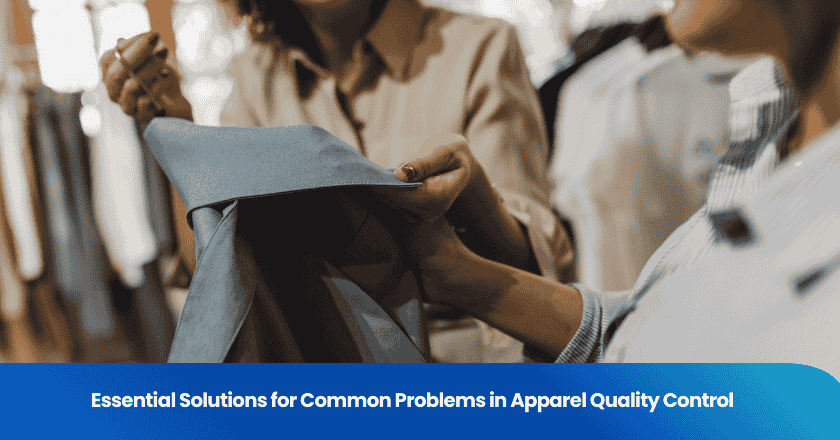
Apparel quality control plays a critical role in the apparel industry. Quality issues can disrupt production, damage reputation, and reduce customer confidence. The apparel industry relies on strong quality management to maintain standards and deliver consistent products. Apparel quality control addresses recurring issues that affect both manufacturers and retailers. Companies in this sector must adopt proactive strategies when handling issues to protect business outcomes and preserve trust.
Key Takeaways
- Strong quality control keeps garments consistent, protects brand reputation, and reduces costly defects.
- Common problems include sizing errors, color mismatches, poor workmanship, and lack of supply chain transparency.
- Regular inspections and clear standards catch defects early and improve product quality.
- Using technology and data tracking helps spot issues faster and supports continuous improvement.
- Training workers and communicating quality goals create a team effort that boosts overall garment quality.
Apparel Quality Control Overview
Why It Matters
Apparel quality control stands at the core of the apparel industry. Companies rely on it to maintain consistency and meet customer expectations. When teams implement strong quality control, they reduce the risk of defective garments reaching the market. This process protects both the reputation and profitability of businesses. The apparel industry faces constant pressure to deliver high standards. Customers expect garments to look good, fit well, and last through repeated use. Quality control ensures that each garment meets these expectations.
Note: Consistent quality control builds trust with buyers and helps companies avoid costly returns or complaints.
The apparel industry also benefits from quality control by improving operational efficiency. Fewer defects mean less waste and lower production costs. As a result, companies can focus on innovation and growth rather than fixing preventable mistakes.
Key Principles
Effective apparel quality control relies on several key principles:
1. Standardization: Teams set clear guidelines for garment specifications, stitching, sizing, and finishing. Standardization helps every worker understand what defines acceptable product quality.
2. Inspection: Regular checks at different production stages catch issues early. Inspection teams examine garments for defects in fabric, construction, and appearance.
3. Documentation: Accurate records track quality control activities. Documentation allows teams to identify trends and address recurring problems.
4. Continuous Improvement: The apparel industry evolves quickly. Companies must review and update quality control processes to stay competitive.
5. Training: Workers receive ongoing education about quality standards and best practices. Training ensures everyone understands their role in maintaining garment quality.
A focus on these principles helps the apparel industry deliver reliable products. Quality control, when applied consistently, supports long-term business success.
Quality Challenges in Garment Production
Garment manufacturing faces a range of quality challenges that can impact both product consistency and customer satisfaction. Identifying these challenges helps companies address defects before they reach the market. Below are the most common quality challenges in garment production:
Product Variability
Product variability remains a significant concern in garment manufacturing. Factories often struggle to maintain uniformity across large batches. Variations in stitching, fabric weight, or finishing can result in garments that look or feel different from one another. These inconsistencies lead to apparel defects that affect brand reputation and customer trust.
Lack of Transparency
Lack of transparency in the supply chain creates obstacles for quality control teams. When factories do not share accurate information about sourcing or production processes, it becomes difficult to trace the origin of defects. This lack of visibility can hide manufacturing problems and delay corrective actions. Companies need clear communication to identify and resolve apparel defects efficiently.
Sizing Issues
Sizing issues frequently arise in garment manufacturing. Inconsistent measurements or poor adherence to size charts can result in garments that do not fit as intended. These defects often lead to high return rates and dissatisfied customers. Standardized measurement protocols help reduce sizing-related apparel defects and improve overall garment quality.
Workmanship Defects
Workmanship defects represent a major source of quality challenges. These defects include loose threads, uneven seams, skipped stitches, or misaligned patterns. Poor workmanship can compromise the durability and appearance of garments. Quality control teams must inspect each stage of garment production to catch these apparel defects early.
Storage and Handling
Improper storage and handling introduce additional risks for garment manufacturing. Exposure to moisture, dust, or excessive pressure can cause defects such as stains, creases, or fabric distortion. These apparel defects may not be visible during production but become apparent when garments reach customers. Proper storage protocols help prevent such issues and maintain product integrity.
Fabric Sourcing
Fabric sourcing plays a crucial role in garment quality. Low-quality or inconsistent fabric supplies can introduce defects before manufacturing even begins. Problems such as color fading, pilling, or uneven texture often originate from poor fabric selection. Reliable sourcing practices reduce the risk of apparel defects and support consistent garment production.
Color Mismatches
Color mismatches present a persistent challenge in garment manufacturing. Variations in dye lots, printing techniques, or fabric absorption rates can result in garments with inconsistent colors. These defects are especially noticeable in multi-piece orders or coordinated collections. Strict color matching procedures help minimize apparel defects related to color inconsistencies.
Note: Addressing these quality challenges early in the garment production process reduces the risk of defects reaching the end consumer. Proactive management of these issues supports higher product standards and customer satisfaction.
Quality Control Solutions
Inspection Protocols
Inspection protocols form the backbone of any quality control programme in garment manufacturing. Teams establish clear guidelines for garment inspection at every stage of production. These protocols outline when and how inspections occur, what quality standards apply, and which apparel defects require immediate attention. Regular inspections help ensure that defects are identified before garments move to the next phase.
Tip: Consistent inspection protocols reduce the risk of unnoticed defects and support continuous improvement in quality control.
A robust inspection process includes visual checks, measurement verification, and functional testing. Teams document findings to track recurring apparel defects and adjust processes as needed.
Technology Integration
Modern garment manufacturing benefits from technology integration in quality control. Digital tools automate inspections, track defects, and analyze production data. For example, computer vision systems can detect stitching errors or color mismatches faster than manual checks. Quality tests performed by automated equipment provide objective results and reduce human error.
Technology also enables real-time monitoring. Teams receive instant alerts when apparel defects occur, allowing for quick corrective action. Data collected from these systems supports effective quality control by identifying trends and preventing future issues.
Inventory Management
Effective inventory management plays a critical role in maintaining garment quality. Proper storage conditions prevent defects caused by moisture, dust, or improper handling. Inventory systems track fabric batches and finished garments, ensuring that only approved materials enter production.
A well-organized inventory reduces the risk of mixing defective items with quality products. Teams can quickly isolate and address apparel defects, minimizing the impact on overall production. Inventory management also supports traceability, making it easier to investigate the source of defects.
Supplier Vetting
Supplier vetting ensures that only reliable partners contribute to garment manufacturing. Companies evaluate suppliers based on their ability to meet quality standards and deliver consistent materials. This process includes reviewing supplier certifications, conducting site visits, and requesting sample products for quality tests.
A thorough vetting process reduces the risk of apparel defects originating from poor-quality fabrics or components. Ongoing supplier assessments help maintain high standards and foster long-term partnerships.
Color Matching Procedures
Color matching procedures address one of the most common apparel defects: color inconsistencies. Teams use standardized color references and calibrated equipment to ensure uniformity across all garments. During production, technicians compare fabric samples to approved color swatches under controlled lighting conditions.
Note: Accurate color matching prevents mismatched garments in coordinated collections and enhances customer satisfaction.
Documented procedures and regular audits help maintain color consistency, reducing the likelihood of defects reaching the market.
Measurement Standards
Measurement standards form a key part of quality control in garment manufacturing. Teams develop detailed size charts and measurement protocols for each garment style. During garment inspection, workers verify that finished products meet these standards.
Consistent measurement practices reduce sizing-related apparel defects and improve customer satisfaction. Clear documentation allows teams to identify and correct deviations quickly.
Production Checkpoints
Production checkpoints serve as critical control points throughout the garment manufacturing process. At each checkpoint, teams perform targeted inspections to catch defects early. These checkpoints may include fabric cutting, sewing, finishing, and packaging stages.
A structured approach to production checkpoints ensures that defects do not accumulate or go unnoticed. Teams can address issues immediately, preventing defective garments from advancing to the next stage. This proactive method supports effective quality control and helps maintain high quality standards.
Callout: Implementing multiple checkpoints increases the likelihood that apparel defects are identified and resolved before products reach customers.
A combination of these solutions creates a comprehensive quality control programme. Each solution targets specific challenges in garment manufacturing, helping companies deliver consistent, high-quality garments to the market.
Quality Assurance Best Practices
Training and Education
Quality assurance in apparel manufacturing depends on effective training and education. Teams receive regular instruction on quality management principles and inspection techniques. Supervisors organize workshops to demonstrate best practices and address common challenges. Employees learn how to identify defects and follow established protocols.
Well-trained staff contribute to consistent quality assurance and reduce errors during production.
A focus on education helps workers understand the importance of quality assurance. Training sessions encourage questions and foster a culture of accountability. Companies that invest in education see improvements in quality management and overall product reliability.
Communication of Standards
Clear communication of standards supports quality assurance across all levels of garment production. Managers distribute written guidelines that outline quality management expectations. Teams refer to these documents during inspections and daily tasks.
- Standard operating procedures define acceptable garment specifications.
- Visual aids illustrate correct stitching, sizing, and finishing techniques.
- Regular meetings reinforce quality assurance goals and address feedback.
A shared understanding of standards ensures that everyone works toward the same objectives. Effective communication reduces confusion and helps teams improve quality throughout the production process.
Continuous Improvement
Continuous improvement drives long-term success in quality assurance. Companies review quality management processes and analyze inspection data to identify areas for enhancement.
| Continuous Improvement Steps | Description |
|---|---|
| Data Collection | Teams gather defect reports and production metrics. |
| Analysis | Managers evaluate trends and root causes. |
| Action | Teams implement changes to improve quality assurance. |
Employees participate in feedback sessions and suggest new ideas for quality management. Management encourages innovation and rewards teams that help improve quality.
Continuous improvement ensures that quality assurance adapts to changing industry standards and customer expectations.
A commitment to ongoing enhancement strengthens quality assurance and supports business growth.
Enhancing Apparel Quality Control
Data Tracking Tools
Data tracking tools support quality management in apparel production. These tools collect and organize inspection data from every stage of manufacturing. Teams use software platforms to monitor defect rates, analyze trends, and identify recurring issues.
- Automated systems record measurements and inspection results.
- Dashboards display real-time data for supervisors.
- Alerts notify teams about deviations from standards.
Tip: Data tracking tools help teams respond quickly to problems and improve quality control efforts.
Accurate data enables managers to make informed decisions. They adjust processes and allocate resources based on reliable information. Data tracking tools also support transparency, making it easier to share results with stakeholders.
Third-Party Audits
Third-party audits strengthen quality management by providing independent evaluations. External auditors review production processes, inspect finished garments, and verify compliance with industry standards.
Audits offer several benefits:
- Objective feedback on quality control efforts.
- Identification of hidden risks and areas for improvement.
- Validation of internal procedures.
Auditors use checklists and sampling methods to assess garment quality. Their reports guide management in refining quality management strategies.
Note: Regular third-party audits build trust with buyers and demonstrate a commitment to high standards.
Realistic Scheduling
Realistic scheduling supports effective quality management in apparel manufacturing. Production teams set achievable timelines for each stage of the process. They consider equipment capacity, workforce availability, and material delivery schedules.
A well-planned schedule reduces stress and minimizes errors. Workers have enough time to complete inspections and address defects.
| Scheduling Practice | Benefit |
|---|---|
| Buffer periods | Allow for rework and checks |
| Staggered deadlines | Prevent bottlenecks |
| Resource allocation | Optimize team performance |
Callout: Realistic scheduling helps teams maintain consistent quality control efforts and adapt to unexpected challenges.
Managers review schedules regularly and adjust them as needed. This approach ensures that quality management remains a priority throughout production.
Quality assurance drives consistent garment production and supports business growth. Teams improve results by adopting inspection protocols, technology integration, and supplier vetting. Quality assurance relies on training, communication, and continuous improvement. Data tracking tools and third-party audits strengthen quality assurance efforts. Realistic scheduling helps maintain quality assurance throughout production.
- Companies that prioritize quality assurance see fewer defects and higher customer satisfaction.
Review current processes and upgrade quality assurance strategies to achieve better outcomes.
FAQ
What is the main goal of apparel quality control?
The main goal of apparel quality control is to ensure that every garment meets established standards for fit, appearance, and durability. Teams use inspections and protocols to catch defects before products reach customers.
How often should teams perform garment inspections?
Teams should perform inspections at every key stage of production. Regular checks help identify defects early and prevent issues from progressing through the manufacturing process.
Why do color mismatches occur in garment production?
Color mismatches often result from differences in dye lots, fabric types, or inconsistent application of color standards. Strict color matching procedures help maintain uniformity across all garments.
What role does training play in quality assurance?
Training equips workers with the knowledge and skills needed to identify defects and follow quality standards. Well-trained staff contribute to consistent product quality and fewer production errors.
How can technology improve apparel quality control?
Technology automates inspections, tracks defects, and provides real-time data. Digital tools help teams respond quickly to problems and support continuous improvement in quality management.
Grow your business with TradeAider Service
Click the button below to directly enter the TradeAider Service System. The simple steps from booking and payment to receiving reports are easy to operate.



